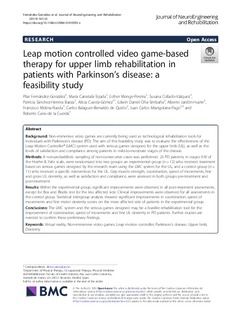| dc.contributor.author | Fernández-González, Pilar | |
| dc.contributor.author | Carratalá-Tejada, María | |
| dc.contributor.author | Monge-Pereira, Esther | |
| dc.contributor.author | Collado-Vázquez, Susana | |
| dc.contributor.author | Baeza, Patricia Sánchez-Herrera | |
| dc.contributor.author | Cuesta-Gómez, Alicia | |
| dc.contributor.author | Oña-Simbaña, Edwin Daniel | |
| dc.contributor.author | Jardón-Huete, Alberto | |
| dc.contributor.author | Molina-Rueda, Francisco | |
| dc.contributor.author | de Quirós, Carlos Balaguer-Bernaldo | |
| dc.contributor.author | Miangolarra-Page, Juan Carlos | |
| dc.contributor.author | Cano-de la Cuerda, Roberto | |
| dc.date.accessioned | 2020-01-09T10:29:20Z | |
| dc.date.available | 2020-01-09T10:29:20Z | |
| dc.date.issued | 2019 | |
| dc.identifier.citation | Fernández-González, P., Carratalá-Tejada, M., Monge-Pereira, E., Collado-Vázquez, S., Sánchez-Herrera Baeza, P., Cuesta-Gómez, A., . . . Cano-de la Cuerda, R. (2019). Leap motion controlled video game-based therapy for upper limb rehabilitation in patients with Parkinson’s disease: a feasibility study. Journal of NeuroEngineering and Rehabilitation, 16(1), 133. | nb_NO |
| dc.identifier.uri | http://hdl.handle.net/11250/2635493 | |
| dc.description.abstract | Background
Non-immersive video games are currently being used as technological rehabilitation tools for individuals with Parkinson’s disease (PD). The aim of this feasibility study was to evaluate the effectiveness of the Leap Motion Controller® (LMC) system used with serious games designed for the upper limb (UL), as well as the levels of satisfaction and compliance among patients in mild-to-moderate stages of the disease.
Methods
A non-probabilistic sampling of non-consecutive cases was performed. 23 PD patients, in stages II-IV of the Hoehn & Yahr scale, were randomized into two groups: an experimental group (n = 12) who received treatment based on serious games designed by the research team using the LMC system for the UL, and a control group (n = 11) who received a specific intervention for the UL. Grip muscle strength, coordination, speed of movements, fine and gross UL dexterity, as well as satisfaction and compliance, were assessed in both groups pre-treatment and post-treatment.
Results
Within the experimental group, significant improvements were observed in all post-treatment assessments, except for Box and Blocks test for the less affected side. Clinical improvements were observed for all assessments in the control group. Statistical intergroup analysis showed significant improvements in coordination, speed of movements and fine motor dexterity scores on the more affected side of patients in the experimental group.
Conclusions
The LMC system and the serious games designed may be a feasible rehabilitation tool for the improvement of coordination, speed of movements and fine UL dexterity in PD patients. Further studies are needed to confirm these preliminary findings. | nb_NO |
| dc.publisher | Journal of NeuroEngineering and Rehabilitation | nb_NO |
| dc.rights | Navngivelse 4.0 Internasjonal | * |
| dc.rights.uri | http://creativecommons.org/licenses/by/4.0/deed.no | * |
| dc.subject | virtual reality | nb_NO |
| dc.subject | non-immersive video games | nb_NO |
| dc.subject | leap motion controller | nb_NO |
| dc.subject | Parkinson’s disease | nb_NO |
| dc.subject | upper limb | nb_NO |
| dc.subject | dexterity | nb_NO |
| dc.title | Leap motion controlled video game-based therapy for upper limb rehabilitation in patients with Parkinson’s disease: a feasibility study | nb_NO |
| dc.type | Journal article | nb_NO |
| dc.source.pagenumber | 133 | nb_NO |
| dc.source.volume | 16 | nb_NO |
| dc.source.journal | Journal of NeuroEngineering and Rehabilitation | nb_NO |
| dc.source.issue | 1 | nb_NO |
| dc.identifier.doi | https://doi.org/10.1186/s12984-019-0593-x | |

